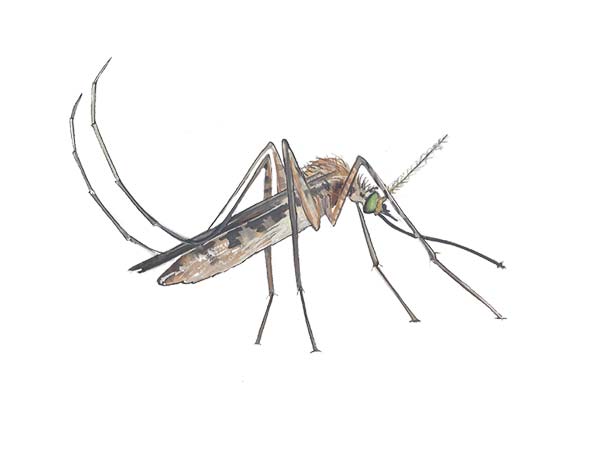
Family: Culicidae
Description
Mosquitoes are small, fly-like insects with two wings and petite legs. Unlike flies, mosquitoes have scales and feathery antennas. The female mosquito has a long feeding tube used to impale skin and suck blood. There are over 3,500 species of mosquitoes, varying in many different sizes, shapes and colors.
Habitat and Biology
Mosquitoes dwell on every continent except Antarctica. Mosquitoes thrive in wet and warm environments. Some species require stagnant water to lay eggs and others require only moist soil. Mosquitoes prefer to live near marshes, forests and tall grassy areas. Most mosquitoes are adverse to direct sunlight and hide on the underside of leaves and shrubs for the majority of the daytime.
Life Cycle
Mosquitoes go through four stages during their life cycle:
- Egg
Most adult mosquito species lay their eggs in stagnant water or damp areas where water can accumulate. Female mosquitoes can lay between 100-200 eggs during the adult lifecycle. Some mosquito species lay eggs singly and others deposit large floating bunches on the surface of the water called rafts.
- Larva
Once the eggs hatch, they become mosquito larva. The mosquito larva has a well-defined head, thorax and abdomen. They dont have legs yet, but instead swim up and down by way of twerking movements with their bodies. For nourishment, mosquito larva feed on algae and bacteria with their mouth brushes.
- Pupa
The mosquito larva will molt into the final pre-adult stage called the pupa. As with the larva, the pupa swims by way of twerking movements through flipping the abdomen. When living in water, the pupa must frequently travel to the surface in order to breath. During the pupa stage, the mosquito does not feed.
- Adult
Once the adolescent stages are complete, the pupa begins to rise to the surface of the water, the dorsal surface splits open and an adult mosquito emerges. Some mosquito species only take 5 days to reach the adult cycle and others take over a month. The adult mosquito begins to feed and reproduce almost immediately after the pupa stage is complete.
Feeding Habits
Mosquitoes are known as blood sucking vampires, but not all mosquitoes drink blood. Both male and female mosquitoes feed on nectar, honeydew and plant juices, but only females will drink blood. Female mosquitoes require the nutrients in blood to reproduce eggs. Only the female mosquito is equipped with a skin-piercing mouthpiece, which allows her to easily drink blood from animals. Female mosquitoes hunt their prey through detecting carbon dioxide, heat, bacteria and sight. Most mosquitoes are crepuscular feeders, feeding primarily during dawn and dusk hours and hiding from the sun for the remainder of the day.
Diseases
Mosquitoes are the deadliest animals on the planet. It is estimated that mosquitoes kill over one million people in the world each year. Mosquitoes carry many different types of disease-causing viruses and parasites, which are then transported to both humans and animals. The most common diseases carried by mosquitoes are malaria, chikungunya, dog heartworm, dengue, yellow fever, easter equine encephalitis, St. Louis encephalitis, lacrosse encephalitis, equine encephalitis and west nile virus. In addition to diseases, mosquitoes can cause severe skin irritation by transferring saliva during a blood meal.
Mosquito Control and Prevention
The best way to prevent mosquito infestations is to create the least desirable habitat for mosquitoes.
How to Create the Least Desirable Habitat:
- Empty out water from containers such as birdbaths, buckets and pots
- Eliminate standing water
- Clean gutters regularly
- Chlorinate the pool
- Keep the lawn and ornamental plants manicured
- Discard of leaf and lawn clippings
- De-clutter the outside of the home
Mosquito Pest Control Treatments
Insecticides are a fast and powerful way to dramatically reduce the mosquito population around the outside of a home. Insecticides such as permethrins are mixed with water and applied around thick vegetation through a fine mist or fog. The treatment disrupts the mosquitos central nervous system, but is not harmful to humans or animals in small amounts. Treatments must be applied on a monthly basis (if not, the sun and rain will break down the molecules and reduce the overall effectiveness.)
- Larvicides
Mosquitoes generally need an inch of water to breed and some only need moist soil. Larvicides are placed in areas where stagnant water accumulates and work to prevent the mosquito eggs from turning into biting adults. Most larvicides will not have any side affects to animals, fish or humans.
- Mosquito Traps
Mosquito traps kill thousands of mosquitoes by producing attractive smells and then drawing the mosquitoes into bags or sticky paper. Some mosquito traps are known to successfully eradicate over 3,000 mosquitoes in a single night.
- Misting Systems
Mosquito misting systems are mechanical devices, which are designed to periodically disburse pesticides around the exterior of the home. Spray nozzles are attached to areas where mosquito populations are the most active and are turned on by either a remote or timer.
Warning: Pesticide is poisonous and should be handled by a pest control professional. Always read the label and follow instructions before use.
We are experts at mosquito control. We proudly serve Sarasota mosquito control, Bradenton mosquito control and surrounding neighborhoods.
You are not the only one with a mosquito problem – many Floridians face mosquito infestations. Call us today for a free quote and mosquito inspection.